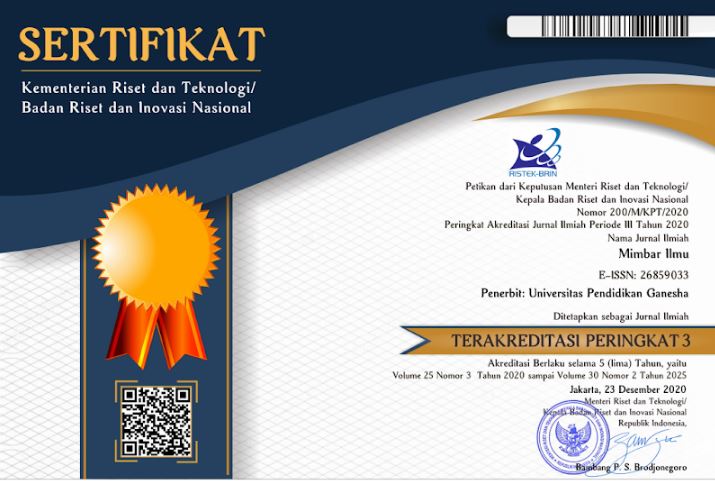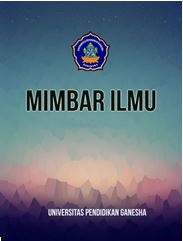BeFind: Start-Up Sports Training Untuk Meningkatkan Industri Olahraga Berbasis Teknologi Digital
DOI:
https://doi.org/10.23887/mi.v27i2.52468Kata Kunci:
START-UP, Sports Training, Industri OlahragaAbstrak
Industri olahraga berbasis teknologi saat ini menjadi arah pengembangan dari Desain Besar Olahraga Nasional yang dicanangkan oleh pemerintah. Oleh karena itu, penelitian ini bertujuan untuk menciptakan befind: start-up sports training untuk meningkatkan industri olahraga berbasis teknologi digital. Penelitian ini merupakan penelitian deskriptif kuantitatif, dengan pengumpulan data menggunakan kuesioner/ angket, wawancara dan studi dokumentasi. Sampel/ responden dalam penelitian ini adalah pelajar dan masyarakat umum dengan rentang usia 16-50 tahun. Sebanyak 171 responden telah mengisi kuesioner analisis kebutuhan pengembangan Start-Up tentang pelatihan olahraga ‘BeFind’. Berdasarkan analisis data yang diperoleh, dapat disimpulkan bahwa; sebagian besar, 84% menyatakan bahwa tujuan berolahraga adalah untuk kebugaran dan kesehatan, sebagian besar 61% responden menyatakan permasalahan yang dialami saat berolahraga adalah sulit mencari informasi terkait pelatihan olahraga. Sebesar 87% menyatakan bersedia mengeluarkan biaya untuk mencapai kebugaran dan kesehatan, dan sebagian besar 88% bersedia menggunakan media teknologi digital/aplikasi untuk mencari informasi dan berlatih olahraga. Hal ini menunjukan bahwa masyarakat sangat membutuhkan media teknologi digital/aplikasi untuk mencari informasi, konsultasi dan berlatih olahraga terhadap pencapaian kebugaran dan kesehatan bahkan juga prestasi olahraga.
Referensi
A., Lenthe, F. J., Van, Tak, N. I., Crawford, D., Brug, J., & Oenema, A. (2010). Availability of sports facilities as moderator of the intention – sports participation relationship among adolescents. Health Education Research, 25(3), 489–497. https://doi.org/10.1093/her/cyq024. DOI: https://doi.org/10.1093/her/cyq024
Abdillah, A. (2019). Pengembangan Model Pembelajaran Motorik Berbasis Permainan. Jurnal Pendidikan Olahraga, 8(2), 138. https://doi.org/10.31571/jpo.v8i2.1446. DOI: https://doi.org/10.31571/jpo.v8i2.1446
Afdi, Z., & Purwanggono, B. (2017). Perancangan strategi berbasis metodologi lean startup untuk mendorong pertumbuhan perusahaan rintisan berbasis teknologi di Indonesia. Industrial Engineering Online Journal, 6(4), 1–13. https://ejournal3.undip.ac.id/index.php/ieoj/article/view/20398.
Agung, A. A. G. (2014). Metodologi Penelitian Pendiidkan. Aditya Media Publishing.
Basoglu, U. D. (2018). The Importance of Physical Literacy for Physical Education and Recreation. Journal of Education and Training Studies, 6(4), 139. https://doi.org/10.11114/jets.v6i4.3022. DOI: https://doi.org/10.11114/jets.v6i4.3022
Bulqini, A., Puspodari, P., Arfanda, P. E., Suroto, S., & Mutohir, T. C. (2021). Physical Literacy in Physical Education Curriculum. ACTIVE: Journal of Physical Education, Sport, Health and Recreation, 10(2), 55–60. https://doi.org/10.15294/active.v10i2.47008. DOI: https://doi.org/10.15294/active.v10i2.47008
Desmawati. (2019). Gambaran Gaya Hidup Kurang Gerak ( Sedentary Lifestyle ) dan Berat Description of Adolescents Sedentary Lifestyle , Obesity in Junior High School , Tangerang Selatan. Jurnal Ilmiah Kesehatan Masyarakat, 11(December 2019), 296–301.
Gabibov, A. B., Polomoshov, A. F., & Ryzhkin, N. V. (2020). Physical Education and Sport in the Era of Information Technology. 28(Ichw), 129–132. https://doi.org/10.2991/ahsr.k.201001.027. DOI: https://doi.org/10.2991/ahsr.k.201001.027
Hadi, A., Nasaruddin, N., & Husniati, H. (2020). Pengaruh Model Pembelajaran Kooperatif Tipe Stad Terhadap Hasil Belajar Pendidikan Jasmani, Olahraga Dan Kesehatan Kelas V Sdn 4 Pringgabaya Tahun Ajaran 2020/2021. Jurnal Ilmiah Pendas: Primary Education Journal, 1(2), 124–133. https://doi.org/10.29303/pendas.v1i2.64. DOI: https://doi.org/10.29303/pendas.v1i2.64
Hybois, S., Siegel, A., Bascou, J., Eydieux, N., Vaslin, P., Pillet, H., & Sauret, C. (2018). Shoulder kinetics during start-up and propulsion with a manual wheelchair within the initial phase of uninstructed training. Disability and Rehabilitation: Assistive Technology, 13(1), 40–46. https://doi.org/10.1080/17483107.2016.1278471. DOI: https://doi.org/10.1080/17483107.2016.1278471
Indrayana, B., & Sadikin, A. (2020). Penerapan E-Learning Di Era Revolusi Industri 4.0 Untuk Menekan Penyebaran Covid-19. Indonesian Journal of Sport Science and Coaching, 2(1), 46–55. https://doi.org/10.22437/ijssc.v2i1.9847. DOI: https://doi.org/10.22437/ijssc.v2i1.9847
Jariono, G., Subekti, N., Indarto, P., Hendarto, S., Nugroho, H., & Fachrezzy, F. (2020). Analisis kondisi fisik menggunakan software Kinovea pada atlet taekwondo Dojang Mahameru Surakarta. Transformasi: Jurnal Pengabdian Masyarakat, 16(2), 133–144. https://doi.org/10.20414/transformasi.v16i2.2635. DOI: https://doi.org/10.20414/transformasi.v16i2.2635
Jayul, A., & Irwanto, E. (2020). Model Pembelajaran Daring Sebagai Alternatif Proses Kegiatan Belajar Pendidikan Jasmani di Tengah Pandemi Covid-19. Jurnal Pendidikan Kesehatan Rekreasi, 6(2), 190–199. https://doi.org/10.5281/zenodo.3892262.
Jurbala, P. (2015). What Is Physical Literacy, Really? Quest, 67(4), 367–383. https://doi.org/10.1080/00336297.2015.1084341. DOI: https://doi.org/10.1080/00336297.2015.1084341
Keegan, R., Barnett, L., & Dudley, D. (n.d.). Literature sampling to inform development of a physical literacy definition and standard for Australia.
Loland, S. (2002). Technology in sport: Three ideal-typical views and their implications. European Journal of Sport Science, 2(1), 1–11. https://doi.org/10.1080/17461390200072105. DOI: https://doi.org/10.1080/17461390200072105
Mali, N. P. (2020). Modern technology and sports performance: An overview. International Journal of Physiology, 5(1), 212–216. https://www.journalofsports.com/pdf/2020/vol5issue1/PartE/5-1-170-175.pdf.
Nissa, Mandriyarini, R., & Choirun, M. S. (2017). Sedentary lifestyle sebagai risiko kejadian obesitas pada remaja SMA stunted di Kota Semarang. Journal of Nutrition College, 6(5), 149–155. https://doi.org/10.14710/jnc.v6i2.16903. DOI: https://doi.org/10.14710/jnc.v6i2.16903
Prasasti, T. I., Solin, M., & Hadi, W. (2019). The Effectiveness of Learning Media Folklore Text of North Sumatera Based on Blended Learning by 10th Grade Students of Vocational High SchoolHarapan Mekar-1 Medan. Budapest International Research and Critics in Linguistics and Education (BirLE) Journal, 2(4), 480–490. https://doi.org/10.33258/birle.v2i4.548. DOI: https://doi.org/10.33258/birle.v2i4.548
Rohmah, L., & Muhammad, H. N. (2021). Tingkat Kebugaran Jasmani dan Aktivitas Fisik Siswa Sekolah. Jurnal Pendidikan Olahraga Dan Kesehatan, 09(01), 511–519. https://ejournal.unesa.ac.id/index.php/jurnal-pendidikan-jasmani/article/view/38199.
Rokhayati, A. (2016). Implementasi Pendekatan Taktis dalam Pembelajaran Pendidikan Jasmani Terhadap Motivasi, Kebugaran Jasmani dan Kemampuan Motorik. Jurnal Pendidikan Jasmani Dan Olahraga, 1(2), 57. https://doi.org/10.17509/jpjo.v1i2.5664. DOI: https://doi.org/10.17509/jpjo.v1i2.5664
Saputra, S. A. (2020). Menjaga Imunitas dan Kesehatan Tubuh melalui Olahraga yang Efektif. Prosiding Seminar Nasional Pendidikan STKIP Kusuma Negara II, II, 33–42. http://jurnal.stkipkusumanegara.ac.id/index.php/semnara2020/article/view/844.
Setiawan, A., Yudiana, Y., Ugelta, S., Oktriani, S., Budi, D. R., & Listiandi, A. D. (2020). Hasil Belajar Pendidikan Jasmani dan Olahraga Siswa Sekolah Dasar: Pengaruh Keterampilan Motorik (Tinggi) dan Model Pembelajaran (Kooperatif). TEGAR: Journal of Teaching Physical Education in Elementary School, 3(2), 59–65. https://doi.org/10.17509/tegar.v3i2.24513. DOI: https://doi.org/10.17509/tegar.v3i2.24513
Sofiany, R., & Setyawati, M. I. (2021). Portrait of The Sedentary Lifestyle. MUHAMMADIYAH Journal of Epidemology, 1(1), 65–72. https://doi.org/https://jurnal.umj.ac.id/index.php/MJE/article/download/9383/5586.
Sugiyono. (2015). Metode Penelitian Kuantitatif Kualitatif. Alfabeta.
Thomas, S. V., & Gilbert, J. E. (2016). Integrating Technology to Enhance Athlete Development: A Literature Review. Journal of Higher Education Athletics & Innovation, 1(1), 73–84. https://doi.org/10.15763/issn.2376-5267.2016.1.1.73-84. DOI: https://doi.org/10.15763/issn.2376-5267.2016.1.1.73-84
Tiffany, A., Yuniar, A., Febrian, A., Austeen, J., Suryaputra, L., Hannah, M., Kevin, T., & Bagas, W. (2020). Strategi Pemilik Bisnis Startup Di Indonesia Hadapi Pandemi Covid-19. Journal VICIDI, 10(2), 55–65. https://journal.uc.ac.id/index.php/vicidi/article/view/1930. DOI: https://doi.org/10.37715/vicidi.v10i2.1930
Utami, A. A., & Saraswati, T. G. (2018). Analisis Model Bisnis pada Bisnis Start-Up Web Hosting di Kota Bandung Mengguakan Business Model Canvas (Studi Kasus pada Qwords.com). E-Proceeding of Management, 5(2), 2538–2546. https://openlibrarypublications.telkomuniversity.ac.id/index.php/management/article/view/6954.
Valenci, C., & Winata, T. (2020). Ruang kreatif digital. Jurnal Sains, Teknologi, Urban, Perancangan, Arsitektur (Stupa), 1(2), 2075. https://doi.org/10.24912/stupa.v1i2.4435. DOI: https://doi.org/10.24912/stupa.v1i2.4435
Yuliana Asnita, Evawany Yunita Aritonang, & Zulhaida Lubis. (2020). The Effect of Sedentary Lifestyle on the Incidence of Obesity on Adolescents in SMUN 7 Banda Aceh. Britain International of Exact Sciences (BIoEx) Journal, 2(1), 53–60. https://doi.org/10.33258/bioex.v2i1.118. DOI: https://doi.org/10.33258/bioex.v2i1.118
Unduhan
Diterbitkan
Cara Mengutip
Terbitan
Bagian
Lisensi
Hak Cipta (c) 2022 Made Agus Dharmadi

Artikel ini berlisensiCreative Commons Attribution-ShareAlike 4.0 International License.
This work is licensed under a Creative Commons Attribution-ShareAlike 4.0 International License.
Authors who publish with this journal agree to the following terms:
- Authors retain copyright and grant the journal right of first publication with the work simultaneously licensed under a Creative Commons Attribution License that allows others to share the work with an acknowledgment of the work's authorship and initial publication in this journal.
- Authors are able to enter into separate, additional contractual arrangements for the non-exclusive distribution of the journal's published version of the work (e.g., post it to an institutional repository or publish it in a book), with an acknowledgment of its initial publication in this journal.
- Authors are permitted and encouraged to post their work online (e.g., in institutional repositories or on their website) prior to and during the submission process, as it can lead to productive exchanges, as well as earlier and greater citation of published work.









